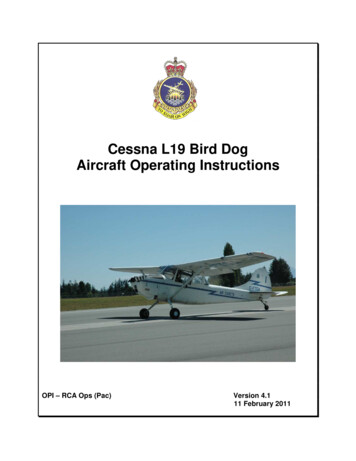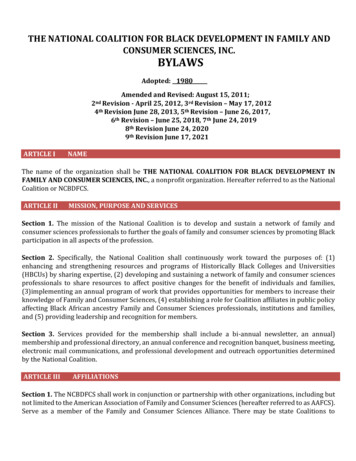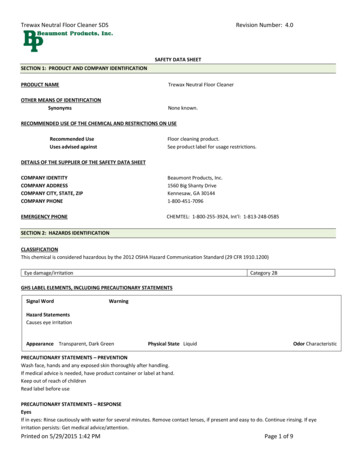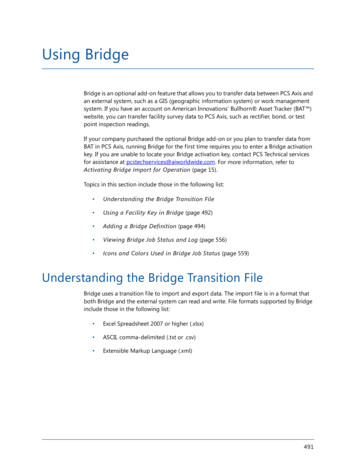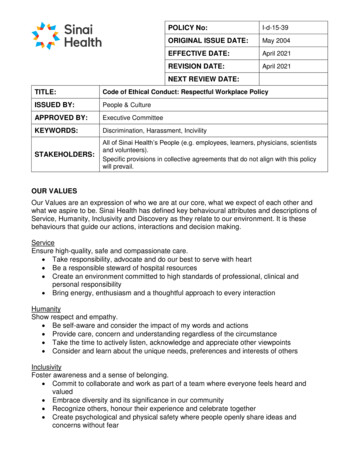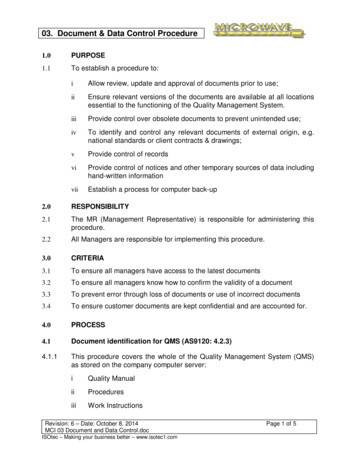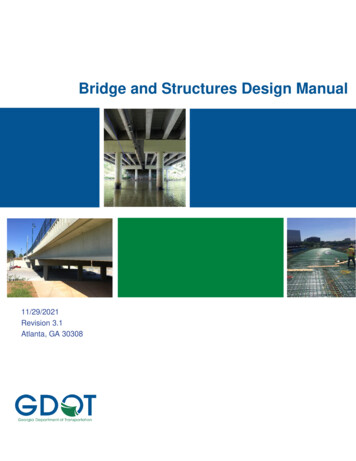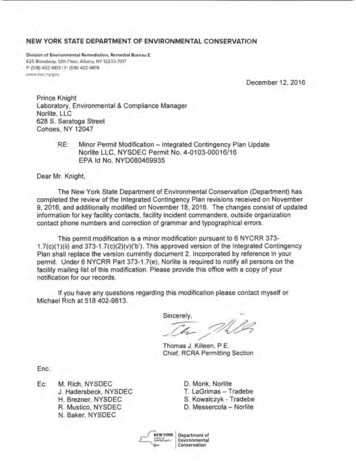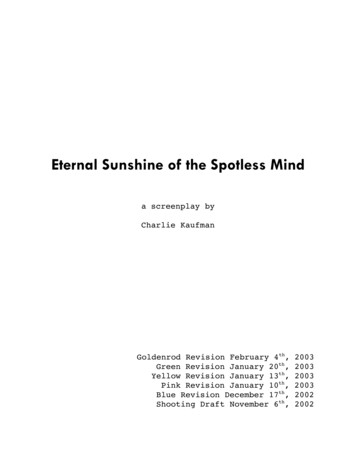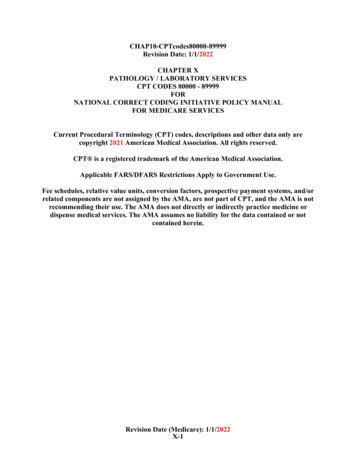
Transcription
CHAP10-CPTcodes80000-89999Revision Date: 1/1/2022CHAPTER XPATHOLOGY / LABORATORY SERVICESCPT CODES 80000 - 89999FORNATIONAL CORRECT CODING INITIATIVE POLICY MANUALFOR MEDICARE SERVICESCurrent Procedural Terminology (CPT) codes, descriptions and other data only arecopyright 2021 American Medical Association. All rights reserved.CPT is a registered trademark of the American Medical Association.Applicable FARS/DFARS Restrictions Apply to Government Use.Fee schedules, relative value units, conversion factors, prospective payment systems, and/orrelated components are not assigned by the AMA, are not part of CPT, and the AMA is notrecommending their use. The AMA does not directly or indirectly practice medicine ordispense medical services. The AMA assumes no liability for the data contained or notcontained herein.Revision Date (Medicare): 1/1/2022X-1
Table of ContentsChapter X . X-3Pathology and Laboratory Services . X-3CPT Codes 80000 - 89999 . X-3A. Introduction . X-3B. Evaluation & Management (E&M) Services . X-4C. Organ or Disease Oriented Panels. X-6D. Evocative/Suppression Testing . X-6E. Drug Testing . X-6F. Molecular Pathology. X-7G. Chemistry . X-8H. Hematology and Coagulation. X-9I. Immunology. X-10J. Transfusion Medicine . X-10K. Microbiology. X-11L. Anatomic Pathology (Cytopathology and Surgical Pathology) . X-12M. Medically Unlikely Edits (MUEs) . X-15N. General Policy Statements . X-20Revision Date (Medicare): 1/1/2022X-2
Chapter XPathology and Laboratory ServicesCPT Codes 80000 - 89999A. IntroductionThe principles of correct coding discussed in Chapter I apply to the Current ProceduralTerminology (CPT) codes in the range 80000-89999. Several general guidelines are repeated inthis Chapter. However, those general guidelines from Chapter I not discussed in this chapter arenonetheless applicable.Providers/suppliers shall report the HCPCS/CPT code that describes the procedure performed tothe greatest specificity possible. A Healthcare Common Procedure Coding System/CurrentProcedural Terminology (HCPCS/CPT) code shall be reported only if all services described bythe code are performed. A provider/supplier shall not report multiple HCPCS/CPT codes if asingle HCPCS/CPT code exists that describes the services. This type of unbundling is incorrectcoding.HCPCS/CPT codes include all services usually performed as part of the procedure as a standardof medical/surgical practice. A provider/supplier shall not separately report these services simplybecause HCPCS/CPT codes exist for them.The Centers for Medicare & Medicaid Services (CMS) often publishes coding instructions in itsrules, manuals, and notices. Providers/suppliers must use these instructions when reportingservices rendered to Medicare patients.The “CPT Manual” also includes coding instructions which may be found in the “Introduction”,individual chapters, and appendices. In individual chapters, the instructions may appear at thebeginning of a chapter, at the beginning of a subsection of the chapter, or after specific CPTcodes. Providers/suppliers should follow “CPT Manual” instructions unless the CMS hasprovided different coding or reporting instructions.Specific issues unique to this section of CPT are clarified in this chapter.Pathology and laboratory CPT codes describe services to evaluate specimens (e.g., blood, bodyfluid, tissue) obtained from patients in order to provide information to the treating physician.Generally, pathology and laboratory specimens are prepared, screened, and/or tested bylaboratory personnel with a pathologist assuming responsibility for the integrity of the resultsgenerated by the laboratory. Certain types of specimens and tests are reviewed or interpretedpersonally by the pathologist. CPT coding for this section includes few codes requiring patientcontact or Evaluation & Management (E&M) services rendered directly by the pathologist. If apathologist provides significant, separately identifiable face-to-face patient care services thatsatisfy the criteria set forth in the E&M guidelines developed by the CMS and the AMA, apathologist may report the appropriate code from the E&M section of the “CPT Manual”.Revision Date (Medicare): 1/1/2022X-3
CMS policy prohibits separate payment for duplicate testing or testing for the same analyte bymore than one methodology. (See definition of analyte in Section N (General Policy Statements),subsection 2.) If, after a test is ordered and performed, additional related procedures arenecessary to provide or verify the result, these would be considered part of the ordered test. Forexample, if a patient with leukemia has a thrombocytopenia, and a manual platelet count (CPTcode 85032) is performed in addition to the performance of an automated hemogram withautomated platelet count (CPT code 85027), it would be inappropriate to report CPT codes85032 and 85027 because the former provides verification for the automated hemogram andplatelet count (CPT code 85027). As another example, if a patient has an abnormal test result andrepeat performance of the test is done to verify the result, the test is reported as 1 unit of servicerather than 2.By contrast, some laboratory test results typically require separate follow-up testing which isimplicit in the physician’s order. Such tests are termed reflex tests. For example, if an RBCantibody screen (CPT code 86850) is positive, the laboratory proceeds to identify the RBCantibody. The reflex test is separately reportable. Similarly, if a urine culture is positive, thelaboratory proceeds to organism identification testing which is separately reportable. In theseexamples, the initial results have limited clinical value without the separate follow-up test.Other laboratory test results may or may not require additional testing in order to have clinicalvalue. This type of additional testing must be distinguished from reflex testing. The additionaltesting is not implicit in the initial physician order. An example is a test for a monoclonal proteinband. The physician’s initial order does not implicitly include any additional testing. Alaboratory shall not routinely perform additional testing to identify the type of monoclonalprotein unless ordered by the treating physician. If the patient has a known monoclonalgammopathy, the additional testing would not be appropriate unless ordered by the treatingphysician.If a laboratory procedure produces multiple reportable test results, only a single HCPCS/CPTcode shall be reported for the procedure. If there is no HCPCS/CPT code that describes theprocedure, the laboratory shall report a miscellaneous or unlisted procedure code with a singleunit of service.Proprietary Laboratory Analyses (PLA) codes are alpha-numeric codes describingmanufacturers' tests.B. Evaluation & Management (E&M) ServicesMedicare Global Surgery Rules define the rules for reporting E&M services with procedurescovered by these rules. This section summarizes some of the rules.All procedures on the Medicare Physician Fee Schedule are assigned a global period of 000, 010,090, XXX, YYY, ZZZ, or MMM. The global concept does not apply to XXX procedures. Theglobal period for YYY procedures is defined by the Medicare Administrative Contractor (MAC).All procedures with a global period of ZZZ are related to another procedure, and the applicableRevision Date (Medicare): 1/1/2022X-4
global period for the ZZZ code is determined by the related procedure. Procedures with a globalperiod of MMM are maternity procedures.Since National Correct Coding Initiative (NCCI) Procedure-to-Procedure (PTP) edits are appliedto same day services by the same provider/supplier to the same beneficiary, certain GlobalSurgery Rules are applicable to the NCCI program. An E&M service is separately reportable onthe same date of service as a procedure with a global period of 000, 010, or 090 days underlimited circumstances.If a procedure has a global period of 090 days, it is defined as a major surgical procedure. If anE&M service is performed on the same date of service as a major surgical procedure for thepurpose of deciding whether to perform this surgical procedure, the E&M service is separatelyreportable with modifier 57. Other preoperative E&M services on the same date of service as amajor surgical procedure are included in the global payment for the procedure and are notseparately reportable. The NCCI program does not contain edits based on this rule becauseMACs have separate edits.If a procedure has a global period of 000 or 010 days, it is defined as a minor surgical procedure.In general, E&M services on the same date of service as the minor surgical procedure areincluded in the payment for the procedure. The decision to perform a minor surgical procedure isincluded in the payment for the minor surgical procedure and shall not be reported separately asan E&M service. However, a significant and separately identifiable E&M service unrelated tothe decision to perform the minor surgical procedure is separately reportable with modifier 25.The E&M service and minor surgical procedure do not require different diagnoses. If a minorsurgical procedure is performed on a new patient, the same rules for reporting E&M servicesapply. The fact that the patient is “new” to the provider/supplier is not sufficient alone to justifyreporting an E&M service on the same date of service as a minor surgical procedure. The NCCIprogram contains many, but not all, possible edits based on these principles.For major and minor surgical procedures, postoperative E&M services related to recovery fromthe surgical procedure during the postoperative period are included in the global surgicalpackage as are E&M services related to complications of the surgery. Postoperative visitsunrelated to the diagnosis for which the surgical procedure was performed unless related to acomplication of surgery may be reported separately on the same day as a surgical procedure withmodifier 24 (“Unrelated Evaluation and Management Service by the Same Physician or OtherQualified Health Care Professional During a Postoperative Period”).Procedures with a global surgery indicator of “XXX” are not covered by these rules. Many ofthese “XXX” procedures are performed by physicians and have inherent pre-procedure, intraprocedure, and post-procedure work usually performed each time the procedure is completed.This work shall not be reported as a separate E&M code. Other “XXX” procedures are notusually performed by a physician and have no physician work relative value units associatedwith them. A provider/supplier shall not report a separate E&M code with these procedures forthe supervision of others performing the procedure or for the interpretation of the procedure.With most “XXX” procedures, the physician may, however, perform a significant and separatelyidentifiable E&M service that is above and beyond the usual pre- and post-operative work of theRevision Date (Medicare): 1/1/2022X-5
procedure on the same date of service which may be reported by appending modifier 25 to theE&M code. This E&M service may be related to the same diagnosis necessitating performanceof the “XXX” procedure but cannot include any work inherent in the “XXX” procedure,supervision of others performing the “XXX” procedure, or time for interpreting the result of the“XXX” procedure.C. Organ or Disease Oriented PanelsThe “CPT Manual” assigns CPT codes to organ- or disease-oriented panels consisting of groupsof specified tests. If all tests of a CPT-defined panel are performed, the provider/supplier shallbill the panel code. The panel codes shall be used when the tests are ordered as that panel. Forexample, if the individually ordered tests are cholesterol (CPT code 82465), triglycerides (CPTcode 84478), and HDL cholesterol (CPT code 83718), the service should be reported as a lipidpanel (CPT code 80061) (See Chapter I, Section N (Laboratory Panel)).The NCCI program contains edits pairing each panel CPT code (Column One code) with eachCPT code corresponding to the individual laboratory tests that are included in the panel (ColumnTwo code). These edits allow use of NCCI PTP-associated modifiers to bypass them if one ormore of the individual laboratory tests are repeated on the same date of service. The repeattesting must be medically reasonable and necessary. Modifiers 59 or 91 may be used to reportthis repeat testing. Based on the “Internet-only Manuals (IOM)”, “Medicare Claims ProcessingManual”, Publication 100-04, Chapter 16, Section 100.5.1, the repeat testing cannot beperformed to “confirm initial results; due to testing problems with specimens and equipment orfor any other reason when a normal, one-time, reportable result is all that is required.”D. Evocative/Suppression TestingEvocative/suppression testing requires the administration of pharmaceutical agents to determinea patient's response to those agents. CPT codes 80400-80439 describe the laboratory componentsof the testing. Administration of the pharmaceutical agent may be reported with CPT codes96365-96376. In the facility setting, these codes may be reported by the facility, but not theprovider/supplier. In the non-facility setting, these codes may be reported by theprovider/supplier. While supplies necessary to perform the testing are included in the testingCPT codes, the appropriate HCPCS Level II J code for the pharmacologic agent may be reportedseparately. E&M services, including prolonged services, should not be reported separately unlessa significant, separately identifiable service medically reasonable and necessary E&M isprovided and documented.E. Drug Testing1.Beginning January 1, 2017, presumptive drug testing may be reported with CPTcodes 80305-80307. These codes differ based on the level of complexity of the testingmethodology. Only one code from this code range may be reported per date of service.Beginning January 1, 2016, definitive drug testing may be reported with HCPCS codes G0480G0483. These codes differ based on the number of drug classes including metabolites tested. OnRevision Date (Medicare): 1/1/2022X-6
January 1, 2017, HCPCS code G0659 defining a different type of definitive drug testing wasadded. Only one code from this group of codes may be reported per date of service.2.Providers performing validity testing on urine specimens used for drug testingshall not separately bill the validity testing. For example, if a laboratory performs a urinary pH,specific gravity, creatinine, nitrates, oxidants, or other tests to confirm that a urine specimen isnot adulterated, this testing is not separately billed.F. Molecular Pathology1.Physician (M.D. or D.O.) interpretation of a molecular pathology procedure (e.g.,CPT codes 81161-81408) may be reported with HCPCS code G0452 when medically reasonableand necessary. It shall not be reported with CPT code 88291 (Cytogenetics and molecularcytogenetics, interpretation and report).Several criteria must be satisfied in order to report HCPCS code G0452. (See Section L(Medically Unlikely Edits (MUEs)), Subsection 4 for reporting requirements related to HCPCScode G0452.) One criterion is that it requires the exercise of medical judgment. If theinformation could ordinarily be furnished by a nonphysician laboratory specialist, the servicedoes not require the exercise of medical judgment.2.Molecular pathology procedures (e.g., CPT codes 81161-81408) include allaspects of sample preparation, cell lysis, internal measures to assure adequate quantity of DNAor RNA, and performance of the assay. These procedures include DNA analysis and/or RNAanalysis.3.Quantitation of extracted DNA and/or RNA is included in the payment for amolecular pathology procedure (e.g., CPT codes 81161-81408). Other HCPCS/CPT codes suchas CPT code 84311 (Spectrophotometry.not elsewhere specified) shall not be reported for thisquantitation.4.Scraping tumor off an unstained slide, if performed, is included in the paymentfor a molecular pathology procedure (e.g., CPT codes 81161-81408). A provider/supplier shallnot report microdissection (CPT codes 88380 or 88381) for this process.5.CPT codes 81445, 81450, and 81455 describe targeted genomic sequenceanalysis. 81445 applies to solid organ neoplasm type (5-50 genes) and 81450 applies tohematolymphoid neoplasm type (5-50 genes), while 81455 applies to the number of genesanalyzed for either a solid or hematolymphoid neoplasm (51 or greater genes).Providers/suppliers may not report 81455 with either 81445 or 81450.6.All genomic sequencing procedures and molecular multianalyte assays (e.g., CPTcodes 81410-81471), many multianalyte assays with algorithmic analyses (e.g., CPT codes81490-81599, 0004M-XXXXM), and many Proprietary Laboratory Analyses (PLA) (e.g., CPTcodes 0001U-XXXXU) are DNA or RNA analytic methods that simultaneously assay multipleRevision Date (Medicare): 1/1/2022X-7
genes or genetic regions. A provider/supplier shall not additionally separately report testing forthe same gene or genetic region by a different methodology (e.g., CPT codes 81105-81408,81479, 88364-88377). CMS payment policy does not allow separate payment for multiplemethods to test for the same analyte.7.A Tier 1 or Tier 2 molecular pathology procedure CPT code should not, ingeneral, be reported with a genomic sequencing procedure, molecular multianalyte assay,multianalyte assay with algorithmic analysis, or proprietary laboratory analysis CPT code wherethe CPT code descriptor includes testing for the analyte described by the Tier 1 or Tier 2molecular pathology code. Procedures reported together must be both medically reasonable andnecessary (e.g., sequencing of procedures) and ordered by the physician who is treating thebeneficiary and using the results in the management of the beneficiary's specific medicalproblem.8.If one laboratory procedure evaluates multiple genes using a nextgeneration sequencing procedure, the laboratory shall report only one unit of service of onegenomic sequencing procedure, molecular multianalyte assay, multianalyte assay withalgorithmic analysis, or proprietary laboratory analysis CPT code. If no CPT code accuratelydescribes the procedure performed, the laboratory may report CPT code 81479 (Unlistedmolecular pathology procedure) with one unit of service or may report multiple individual CPTcodes describing the component test results when medically reasonable andnecessary. Procedures reported together must be both medically reasonable and necessary (e.g.,sequencing of procedures) and ordered by the physician who is treating the beneficiary and usingthe results in the management of the beneficiary's specific medical problem.9.PTP edits bundling 2 Tier 1 molecular pathology procedure CPT codes describeprocedures that should not, in general, be reported together. For example, CPT code 81292describes full sequence gene analysis of MLH1, and CPT code 81294 describesduplication/deletion variant gene analysis of MLH1. In evaluating a patient with coloncarcinoma (vs. constitutional genetic disorder), it may be appropriate to performduplication/deletion testing if the disease variant(s) is (are) not identified by performing full genesequencing. The same principle applies to other code pair combinations of testing for the samegene (e.g., 81295/81297, 81298/81300). Procedures reported together must be both medicallyreasonable and necessary (e.g., sequencing of procedures) and ordered by the physician who istreating the beneficiary and using the results in the management of the beneficiary's specificmedical problem.G. Chemistry1.CPT code 83721 (Lipoprotein, direct measurement; LDL cholesterol) describesdirect measurement of LDL cholesterol. It shall not be used to report a calculated LDLcholesterol.2.Free thyroxine (CPT code 84439) is generally considered to be a better measureof the hypothyroid or hyperthyroid state than total thyroxine (CPT code 84436). If free thyroxineis measured, it is not considered appropriate to measure total thyroxine with or without thyroidRevision Date (Medicare): 1/1/2022X-8
hormone binding ratio (CPT code 84479). The NCCI program does not permit payment of CPTcodes 84436 or 84479 with CPT code 84439.3.This subsection was moved to Section E (Drug Testing), Subsection 1.4.CPT code 83704 (Lipoprotein, blood; quantitation of lipoprotein particlenumber(s) (e.g., by nuclear magnetic resonance spectroscopy) includes lipoprotein particlesubclass(es), when performed) is generally not reported on the same date of service as CPTcodes 80061 (Lipid panel.), 82465 (Cholesterol.total), 84478 (triglycerides), and 83718(Lipoprotein, direct measurement; high density cholesterol (HDL cholesterol)). Typically, a lipidpanel is performed, and if necessary, the physician may order an NMR lipoprotein panel as afollow-up study to further characterize the abnormality. However, uncommonly a patient mighthave a previously diagnosed lipid panel abnormality and separate NMR lipoprotein panelabnormality that require retesting after a therapeutic intervention.H. Hematology and Coagulation1.If a treating physician orders an automated complete blood count with automateddifferential WBC count (CPT code 85025) or without automated differential WBC count (CPTcode 85027), the laboratory sometimes examines a blood smear in order to complete the orderedtest based on laboratory selected criteria flagging the results for additional verification. Thelaboratory shall not report CPT code 85007 (Blood count; blood smear, microscopicexamination with manual WBC differential count) or CPT code 85008 (Blood count; bloodsmear, microscopic examination without manual WBC differential count) for the examination ofa blood smear to complete the ordered automated complete blood count (CPT codes 85025 or85027). The same principle applies if the treating physician orders any type of blood count andthe laboratory’s practice is to perform an automated complete blood count with or withoutautomated differential WBC count.2.If a treating physician orders an automated hemogram (CPT code 85027) and amanual differential WBC count (CPT code 85007), both codes may be reported. However, aprovider/supplier may not report an automated hemogram with automated differential WBCcount (CPT code 85025) with a manual differential WBC count (CPT code 85007) because thiscombination of codes results in duplicate payment for the differential WBC count. The CMSdoes not pay twice for the same laboratory test result even if performed by 2 different methodsunless the 2 methods are medically reasonable and necessary.3.Multiple CPT codes describe bone and bone marrow biopsy and/or aspiration andinterpretation of the specimens. If a bone biopsy is performed for evaluation of bone matrixstructure, the appropriate CPT codes to report are CPT code 20220 for the biopsy and CPT code88307 for the surgical pathology interpretation.If diagnostic bone marrow aspiration(s) is(are) performed without biopsy, the procedure may bereported as CPT code 38220. Interpretation of the aspirate smear(s) may be reported as CPT code85097. Both codes may be reported by the same provider/supplier if both the procedure andRevision Date (Medicare): 1/1/2022X-9
interpretation are performed by that physician. If a cell block is prepared from the bone marrowaspirate(s), interpretation of the cell block may be reported as CPT code 88305.Diagnostic bone marrow biopsy(ies) may be reported with CPT code 38221. If bone marrowaspiration(s) is(are) also performed on the same bone, the biopsy(ies) and aspirations(s)may bereported with CPT code 38222. However, CPT code 38221 shall not be reported with CPT code38220 for the same bone. Interpretation of the bone marrow biopsy(ies) may be reported withCPT code 88305.The bone marrow aspiration(s) procedure (CPT code 38220) shall not be reported separatelywith the bone marrow biopsy(ies) procedure (CPT code 38221) unless the 2 procedures areperformed on different bones or at separate patient encounters on the same date of service.When it is medically necessary to evaluate both bone structure and bone marrow and both can beevaluated from a single biopsy, only one code (CPT code 38221 or 20220) shall be reported forthe surgical procedure. If 2 separate biopsies are medically necessary, both may be reportedappending modifier 59 or XS to one of the codes. If only one specimen is submitted for surgicalpathology, only one surgical pathology code (CPT codes 88305 or 88307 as appropriate) may bereported even if the report includes evaluation of both bone structure and bone marrowmorphology.Bone marrow biopsy(ies) is(are) typically performed with a Jamshidi needle yielding acylindrical core of bone and marrow. The surgical pathology interpretation of this type ofspecimen is reported with CPT code 88305. A bone biopsy is typically performed with adifferent instrument and yields a larger non-cylindrical bony specimen which may include somebone marrow. The surgical pathology interpretation of this type of specimen may be reportedwith CPT code 88307.I. ImmunologyAllergen specific IgE testing may be performed using crude allergen extracts (CPT code86003) or recombinant or purified components (CPT code 86008). Both procedures may bereported for the same date of service if the 2 types of testing are performed for differentallergens. Both procedures may also be reported for the same date of service if allergen specificIgE crude extract testing is positive and allergen specific IgE component testing for that crudeallergen is ordered by the treating physician and is used for management of the patient’s specificmedical problem. The laboratory shall not routinely perform allergen specific IgE componenttesting when the allergen specific IgE crude allergen extract test is positive.J. Transfusion MedicineBlood products are described by HCPCS Level II P codes. If a P code describes anirradiated blood product, CPT code 86945 (Irradiation of blood product, each unit) shall not bereported separately since the P code includes irradiation of the blood product. If a P codedescribes a CMV negative blood product, CPT codes 86644 and/or 86645 (CMV antibody) shallnot be reported separately for that blood product since the P code includes the CMV antibodytesting. If a P code describes a deglycerolized blood product, CPT codes 86930 (Frozen blood,Revision Date (Medicare): 1/1/2022X-10
each unit; freezing (includes preparation)), 86931 (Frozen blood, each unit; thawing), and/or86932 (Frozen blood, each unit; freezing (includes preparation) and thawing) shall not bereported separately since the P code includes the freezing and thawing processes. If a P codedescribes a pooled blood product, CPT code 86965 (Pooling of platelets or other blood products)shall not be reported separately since the P code includes the pooling of the blood products. If theP code describes a “frozen” plasma product, CPT code 86927 (Fresh frozen plasma, thawing,each unit) shall not be reported separately since the P code includes the thawing process.K. Microbiology1.CPT codes 87040-87158 describe microbiological culture studies. The type ofculture is coded to the highest level of specificity regarding source, type, etc. When a culture isprocessed by a commercial kit, report the code that describes the test to its highest level ofspecificity. A screening culture and culture for definitive identification are not performed on thesame day on the same specimen and therefore are not reported together.2.Infectious agent molecular diagnostic testing using nucleic acid probes is reportedwith CPT codes such as 87471-87801, 87910, 87901, 87906, 87912, 87902, 87903, and 87904.These CPT codes include all the molecular diagnostic analyses/processes.3.This section was deleted January 1, 2022.4.The test described by CPT code 87624 (Infectious agent detection by nucleic acid(DNA or RNA); Human Papillomavirus (HPV), high-risk types (e.g., 16, 18, 31, 33, 35, 39, 45,51, 52, 56, 58, 59, 68)) generally includes detection of HPV types 16, 18, and 45, as well as otherhigh risk types. CPT code 87625 (Infectious agent detection by nucleic acid (DNA or RNA);Human Papillomavirus (HPV), types 16 and 18 only, includes type 45, if performed) describesdetection of the subset of HPV types 16, 18 and 45. It would be incorrect to report CPT code87625 as a component of screening for a larger number of HPV
example, if the individually ordered tests are cholesterol (CPT code 82465), triglycerides (CPT code 84478), and HDL cholesterol (CPT code 83718), the service should be reported as a lipid panel (CPT code 80061) (See Chapter I, Section N (Laboratory Panel)). The NCCI program contains edits pairing each panel CPT code (Column One code) with each .
